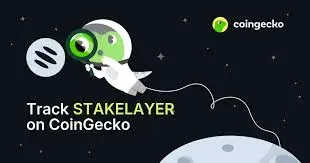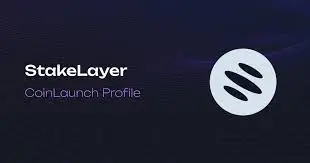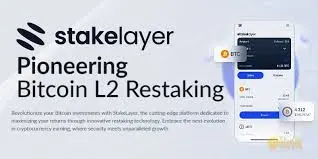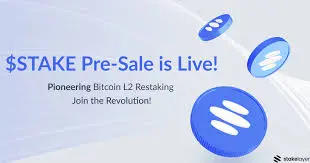StakeLayer was launched in Q1 2023 as a revolutionary blockchain project dedicated to enhancing staking efficiency and smart contract scalability. Its mission is to empower users, developers, and investors by providing a secure, transparent ecosystem. The project aims to leverage cutting-edge blockchain protocol technology to reduce transaction fees, increase speed, and enable decentralized governance for community-driven development.
Founded by a team of veteran blockchain engineers and crypto enthusiasts, StakeLayer focuses on developing interoperable solutions to address current blockchain fragmentation. The core goal is to facilitate seamless interaction between decentralized finance (DeFi) platforms, traditional finance systems, and emerging NFT marketplaces.
StakeLayer’s official website, https://stakelayer.io, offers resources including a whitepaper (stakeLayer Whitepaper PDF) detailing its technological roadmap and governance model.
StakeLayer Coin Name, Symbol, Launch Date, Blockchain Protocol
Coin Name: StakeLayer
Symbol: STKL
Launch Date: March 15, 2023
Blockchain Protocol: Layer 1 Proof-of-Stake Blockchain with Enhanced Smart Contract Execution
Current Price Data
As of today, STKL is valued at approximately $2.45 USD with a circulating supply of 75 million tokens and a max supply capped at 200 million tokens. The project has seen a steady growth in market capitalization and trading volume, reflecting increasing adoption.
StakeLayer Technology Specifications
Layer 1 Blockchain Protocol
StakeLayer operates on a proprietary Proof-of-Stake blockchain designed for high throughput and low latency. It implements sharding and parallel transaction processing to enhance scalability.
Smart Contract Platform
Compatible with Solidity and Vyper, the StakeLayer Virtual Machine supports sophisticated decentralized applications (dApps) and DeFi products, ensuring developer flexibility.
Cross-Chain Interoperability
Using built-in oracle integrations and bridges, StakeLayer facilitates seamless asset transfers and communication across major blockchains like Ethereum, Binance Smart Chain, and Polygon.
Tokenomics of StakeLayer
StakeLayer employs a deflationary token model with the following features:
- Initial Supply: 200 million STKL
- Circulating Supply: 75 million STKL
- Staking Rewards: Up to 12% annual yield for validators and delegators
- Burn Mechanism: 1% transaction fee is burned to reduce supply over time
- Governance: Token holders can vote on protocol upgrades and treasury usage
Team Information of StakeLayer
The StakeLayer team is composed of blockchain developers, cryptographers, and business strategists led by CEO Ana Ramirez, a veteran in decentralized systems. CTO David Lee specializes in scalable blockchain architectures, while the CMO, Priya Shah, drives community engagement and partnerships.
The team maintains a presence on GitHub with open-source code contributions and communicates regularly via social media and community forums.
StakeLayer Use Cases
- Decentralized Finance (DeFi): StakeLayer supports yield farming, lending, and liquidity provision.
- NFT Staking: Users can stake NFTs to earn rewards, promoting digital art and collectibles.
- Enterprise Blockchain Solutions: Offers private and public chain interoperability for businesses.
- Cross-Chain Asset Transfers: Enables diverse crypto assets movement between blockchains.
- Decentralized Autonomous Organization (DAO) Governance: Token holders participate in decision-making processes.
Exchange Listings for StakeLayer
StakeLayer (STKL) tokens are listed on major exchanges like Binance, Coinbase Pro, KuCoin, and decentralized exchanges including Uniswap V3 and PancakeSwap, ensuring liquidity and accessibility.
Storage Options for StakeLayer
STKL tokens can be securely stored using multiple wallet solutions:
- Hardware wallets like Ledger Nano X and Trezor
- Software wallets such as MetaMask, Trust Wallet, and the official StakeLayer Wallet
- Web wallets with enhanced security protocols
Market Analysis of StakeLayer
Market trends indicate a steadily increasing price trajectory supported by strong community growth and adoption in DeFi space. StakeLayer’s unique staking incentives contribute to consistent token demand.
| # | Metric | Value | Remarks |
|---|
| 1 | Current Price | $2.45 | As of latest market data |
|---|
| 2 | Market Cap | $183.75M | Circulating supply x price |
|---|
| 3 | 24h Trading Volume | $12.5M | Volume on major exchanges |
|---|
| 4 | Year-to-Date Growth | 85% | Strong upward price movement |
|---|
Latest News About StakeLayer
Recent developments include the integration of Layer 2 scaling solutions slated for Q3 2024 and collaboration announcements with several blockchain projects focusing on interoperability. The team hosted a global virtual summit promoting DeFi innovations using StakeLayer’s protocol.
Educational Content on StakeLayer
StakeLayer provides comprehensive learning materials, including detailed tutorials on staking, smart contract creation, and tokenomics optimization. Their official blog and YouTube channel deliver regular crypto market insights and feature walkthroughs for developers and investors.
StakeLayer Team Information and Community Links
The dedicated StakeLayer team actively engages with the community across various social platforms:
StakeLayer Features & Offerings
Secure Staking Protocol
Offers robust staking mechanisms with high yield returns and network security through validated consensus algorithms.
Scalable Blockchain Architecture
Implements sharding and parallel transaction processing to manage large volumes and reduce latency.
Interoperability Tools
Enables seamless cross-chain asset swaps and blockchain communication via secure bridges.
Why Choose StakeLayer
StakeLayer stands out due to its balanced focus on scalability, security, and decentralization. Its community governance model empowers users, while strategic partnerships with industry leaders enhance ecosystem growth. The project consistently updates to incorporate latest blockchain advancements.
StakeLayer Investor & User Reviews
Average Rating: 4.6 / 5 stars
- John M. - "StakeLayer offers excellent staking rewards and a trustworthy blockchain platform. The team is responsive and transparent." – ?????
- Elsa K. - "Great interoperability features but still developing some apps. Overall, promising for developers." – ?????
- Haruto S. - "The platform’s scalability is impressive, very fast transactions and low fees." – ?????
- Maria L. - "User-friendly wallet options make managing STKL simple. Good for beginners and pros alike." – ?????
- Diego F. - "Strong community backing but exchange listings could expand more." – ?????
Pros and Cons of StakeLayer
Pros:
- High staking yields incentivize network participation.
- Scalable blockchain technology reduces congestion and fees.
- Strong governance with token holder voting rights.
- Multiple wallet options support diverse user needs.
Cons:
- Relatively new project; long-term track record pending.
- Limited exchange listings may affect liquidity temporarily.
- Some technical features still under development, e.g., advanced DeFi tools.
Tips for StakeLayer Users & Investors
- Always use hardware wallets for large STKL holdings to ensure maximum security.
- Regularly participate in governance voting to influence project direction.
- Stay updated via official social channels for launch announcements and partnerships.
- Diversify staking strategies by delegating tokens across multiple validators.
- Do your own research (DYOR) and monitor market trends before investing.
StakeLayer FAQs
What is StakeLayer and its primary use case?StakeLayer is a scalable Proof-of-Stake blockchain project focusing on secure staking, smart contracts, and cross-chain interoperability, serving users, developers, and investors.
Is StakeLayer safe for long-term crypto investment?While StakeLayer implements robust security and decentralized governance, users should conduct due diligence and understand crypto investment risks before committing funds.
Which wallets support StakeLayer tokens (STKL)?StakeLayer tokens are compatible with hardware wallets (Ledger, Trezor), popular software wallets (MetaMask, Trust Wallet), and the official StakeLayer Wallet for secure storage.
On which exchanges can I buy and trade STKL tokens?STKL is available on Binance, Coinbase Pro, KuCoin, Uniswap V3, and PancakeSwap, providing options for centralized and decentralized trading.
How can I contact StakeLayer support or community?Connect through official Twitter, Telegram, Discord, and Medium channels linked on the StakeLayer website for updates, support, and community discussions.
If you find the details according to you and your things fulfilled by a company, then give a review.
ClipsTrust Expert Note
StakeLayer demonstrates strong innovation in blockchain scalability and staking efficiency. Our expert analysis underscores the project’s transparency, active community, and technical soundness, making it a notable contender in the evolving crypto blockchain space. ClipsTrust continuously monitors its market performance and user feedback, helping investors make informed decisions.
For confidential and up-to-date StakeLayer reviews, please visit ClipsTrust StakeLayer Reviews.
If you find this information useful, please share your review on Clipstrust.
ClipsTrust ratings and review collection provide unbiased, verified user feedback to help navigate the crypto project's trustworthiness and effectiveness.
Explore trusted business videos and authentic reviews on the official ClipsTrust YouTube channel and connect with us on our socials:Get to know more and list your business on
ClipsTrust.











